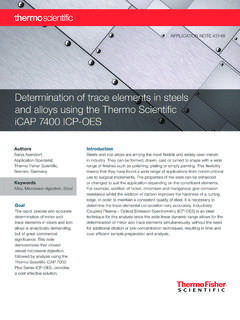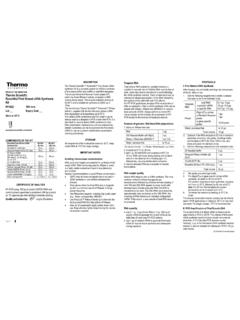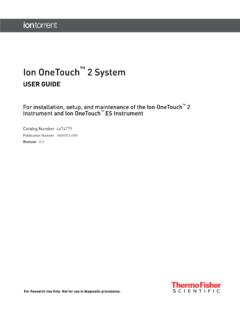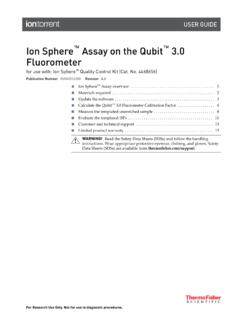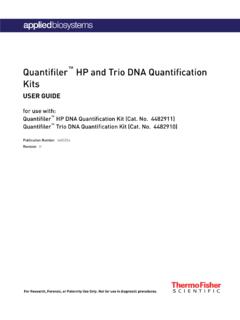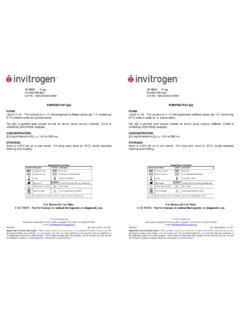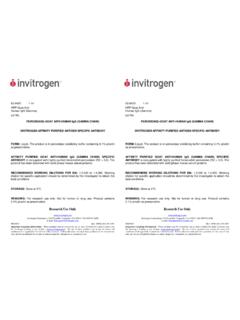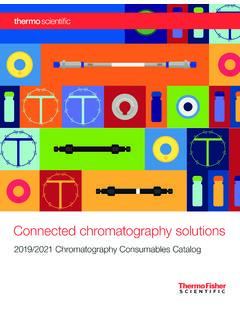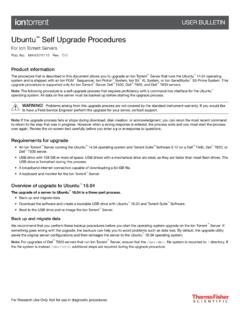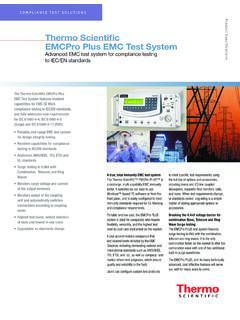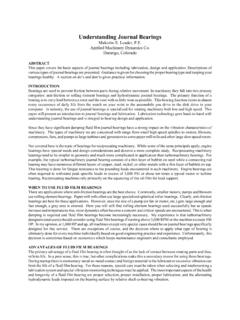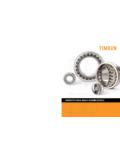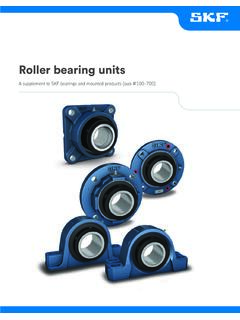Transcription of Lubricating Oil Analysis According to ASTM D5185 using …
1 Lubricating oil Analysis According to astm D5185 using the Thermo Scientific iCAP 7400 ICP-OES APPLICATION NOTE 43158 AuthorsNora Bartsch, Application Specialist, Thermo Fisher Scientific, Bremen, GermanyKeywordsAdditives, Contaminants, Used oil, Wear metalsIntroductionAnalysis of used Lubricating oil for wear metals, contaminants and additive elements is a valuable diagnostic tool to schedule preventative maintenance of engines and machinery. The cost of unscheduled maintenance can be high, not only in materials and labor, but also in lost profits due to down time. Once the oil has been sampled, Analysis by ICP-OES is very useful for aiding with maintenance scheduling, basing decisions on the results of Analysis . ICP-OES is an ideal technique due to its high temperature source which dissociates any organometallic compounds such as zinc dialkyldithio-phosphates, an additive used as anti-wear in motor oil, and also has the ability to handle difficult organic solvent matrices.
2 This allows the oil to be directly aspirated into the instrument after a simple dilution, negating the need for any time consuming digestion sample preparations and consequently enabling faster turnaround application note describes the Analysis of oils in accordance with standard test method astm D5185 for Determination of Additive Elements, Wear Metals, and Contaminants in Used Lubricating Oils and Determination of Selected Elements in Base Oils by ICP-OES . The Thermo Scientific iCAP 7400 ICP-OES Radial used for the Analysis combines high matrix tolerance and reduced matrix-based interferences with a simple and efficient sample introduction design for optimized method astm D5185 ScopeThe standard method astm D5185 is for Determination of Additive Elements, Wear Metals, and Contaminants in Used Lubricating Oils and Determination of Selected Elements in Base Oils by ICP-OES . A total of 22 elements can be determined by this test method and it is generally used as a rapid screening method to monitor the condition of the equipment using the oil and to define when preventative action is needed.
3 The metallic analytes must be oil soluble for accurate quantification. The quantification of insoluble particles such as small particles (greater than a few micrometers) of metal dislodged from a mechanical part is not possible when using this method and any attempt to do so will result in low recoveries. This is due to the plasma not fully atomizing larger particles. It should also be highlighted that obtaining a representative sample would be difficult in such of test methodAn aliquot of a homogenized sample is diluted by weight with a suitable solvent (mixed xylenes). Standards are prepared in the same manner. The concentration of metals within a sample is then determined by direct Analysis using Thermo Scientific iCAP 7400 ICP-OES Radial was chosen for the Analysis . The radial instrument configuration was selected for its high matrix tolerance and reduced matrix interferences. The iCAP 7400 ICP-OES is fully compatible with the Teledyne CETAC ASX-1400 Stirring autosampler which ensures good homogeneity of the solutions developmentReagents The following reagents and standards were used in this work: Xylene (Fisher Scientific, Loughborough, UK); Conostan base oil (Conostan SCP SCIENCE, Baie- D Urf , Canada); S21 Conostan oil-based standard 900 mg kg-1 (Ag, Al, B, Ba, Ca, Cd, Cr, Cu, Fe, Mg, Mn, Mo, Na, Ni, P, Pb, Si, Sn, Ti, V, Zn); Conostan oil-based standard 5000 mg kg-1 S; Conostan oil-based standard 5000 mg kg-1 Y.
4 The following standard reference materials (SRM) and samples were analyzed: wear metals in Lubricating oil NIST SRM 1084a (approximate concentrations 100 mg kg-1); wear metals in Lubricating oil NIST SRM 1085b (approximate concentrations 300 mg kg-1); Quartz 7000 oil (Total); Quartz 7000 oil (Total) 200 hours use; Quartz 7000 oil (Total) 400 hours use. Sample and standard preparation Prior to any sample or stock standard being diluted, it was homogenized by sonication. For very viscous oils, the sample can be pre-heated to 60 C. The yttrium oil-based standard was diluted (by weight) in xylene to give a final concentration of 10 mg kg-1. This solution was used for all dilutions, the yttrium being used as an internal standard. For all samples and standards, the final solution contained 10% oil (by weight) to ensure that differences in viscosity were minimized. To achieve this, base oil was added if required to the standards prior to dilution with the solvent.
5 A blank was obtained by diluting the base oil in the dilution solvent ten-fold. The standards were prepared by diluting the stock standard by weight with the dilution solvent to give the required concentration. Separate standards for sulfur were prepared as the Conostan S21 standard contains metal sulfonates, hence sulfur. A check standard was prepared from a second source (NIST 1084a) in the same manner as the standards. All samples were diluted ten-fold by weight with the diluent solution. Instrument parameters The peristaltic pump was fitted with Solvent Flex pump tubing to introduce the sample and remove waste from the spray chamber. A V-groove nebulizer was used in conjunction with a baffled spray chamber. This combination was selected because it reduces the overall amount of solvent reaching the plasma and shows good efficiency at removing large particles from the sample aerosol. It is the standard organic sample introduction system used in the iCAP 7000 Plus Series ICP-OES.
6 The plasma was then ignited and the appropriate parameters set (see Table 1). Xylene was aspirated for a period of 20 minutes prior to Analysis . The method astm D5185 calls for wavelength profiling to be carried out prior to Analysis . Due to the stability and intelligent design of the iCAP 7400 ICP-OES, this is not 1. Instrument Tubing (Standard Pump)Sample Solvent Flex orange/white Drain Solvent Flex white/white Spray ChamberBaffled cyclonicNebulizerV-grooveCenter mmPump Speed40 rpmNebulizer Gas L min-1 Auxiliary Gas L min-1 Coolant Gas Flow12 L min-1RF Power1150 WRadial Viewing Height12 mmUsing the intuitive wavelength selection tool of the Thermo Scientific Qtegra Intelligent Scientific Data Solution (ISDS) Software, wavelengths were selected that were most likely to be free from interferences in this matrix. astm D5185 also gives a non-exhaustive list of suggested wavelengths that can be used as a guideline. Once each of the samples and standards were analyzed the sub-array plots were examined and changes were made to correct for interferences, as necessary.
7 From the results obtained it was found that no mathematical correction factors such as Inter-Element Correction (IEC) were instrument was calibrated and a check standard was run (NIST 1084a). The measured value of the check is required to be within 5% of the certified value for the Analysis to continue, both after the initial calibration and at regular intervals every fifth sample. The following sequence was then analyzed 8 times: Blank NIST 1085b Quartz 7000 oil (Total) Quartz 7000 oil (Total) 200 hours use Quartz 7000 oil (Total) 400 hours use Check standard NIST 1084aResultsThe results of the sample Analysis can be seen in Table 2. Although the iCAP 7400 ICP-OES Radial is capable of detecting low concentrations, as demonstrated by the results of elements such as aluminium, astm D5185 expects detectability in the low mg kg-1 range for most elements to be sufficient. Focus is on trend Analysis and identification of high concentrations of wear metals and additives in the oil/engine under study.
8 The recovery of the check standard was better than 5% for the 9 analyses performed. The certified standard NIST SRM 1085b was also analyzed and results were within 5% of the expected values. As described in the standard method, certified standards should be regularly analyzed to verify accuracy and precision of the instrument 2. Average results of the sample Analysis in mg and wavelengthNew oilIntermediate oilOld oilAg nm110 322933014Cd nm0 .150 . nm0 . nmND0 . nm573157765134Si nm1038114 3110 6 For Research Use Only. Not for use in diagnostic procedures. 2017 Thermo Fisher Scientific Inc. All rights reserved. CONOSTAN : A Division of SCP SCIENCE. Teledyne and CETAC are trademarks of Teledyne CETAC Technologies. All other trademarks are the property of Thermo Fisher Scientific and its subsidiaries. This information is presented as an example of the capabilities of Thermo Fisher Scientific products.
9 It is not intended to encourage use of these products in any manner that might infringe the intellectual property rights of others. Specifications, terms and pricing are subject to change. Not all products are available in all countries. Please consult your local sales representative for details. AN43158 -EN 0 617 Find out more at 1 shows that as the oil is used in an engine, the elemental composition changes. In this case, the concentration of iron has increased which indicates possible wear of a number of components such as piston rings, ball/roller bearings or gears. The concentration of magnesium decreased with increased usage, possibly indicating that the additive components were consumed or lost from the solution, and the concentration of silicon remained constant which would indicate that the air filter is still intact and preventing dust entering the engine. Elemental profile of oil analysedOil useConcentration (mg/kg-1)FeFeMg (cons/10)Mg (cons/10)Old oilNew oil0102030405060708090 Intermediate OilSlSlFigure 1.
10 Changing elemental composition of an aging The Thermo Scientific iCAP 7400 ICP-OES Radial is capable of meeting the requirements of the standard method astm D5185 which details direct Analysis of Lubricating oils for wear metals and additives. The high matrix tolerance of this system is ideal for such challenging Analysis whilst the speed of the instrument means the iCAP 7400 ICP-OES Radial is capable of high throughput Analysis . Typical Analysis times of less than two minutes are achieved, which is often a requirement for analyzing used oil samples in laboratories facing both a high volume of samples and the constraint for fast turnaround Analysis times. Time is undeniably a key factor in preventative maintenance and reducing down time costs.
